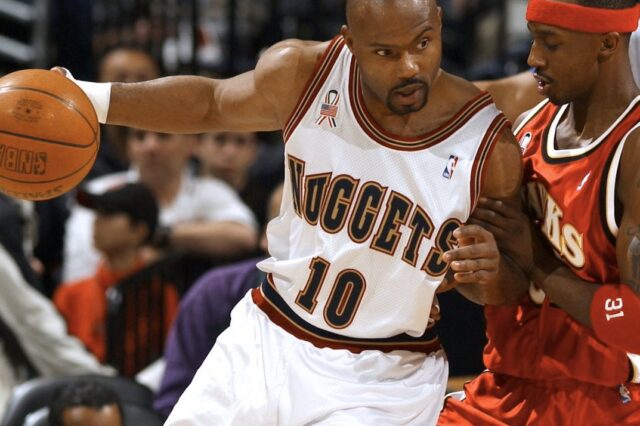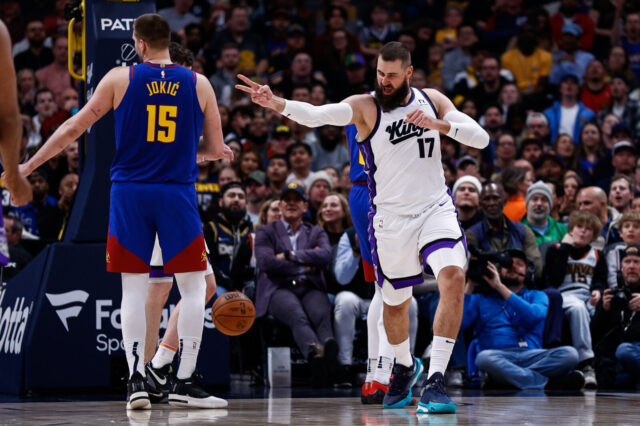Jamal Murray had an up and down rookie season, filled with the normal flashes and bumps in the road all rookies endure as they grow accustomed to the NBA. The bumps were difficult, beginning immediately with Murray’s 0/18 start from the field this year. At times, Murray went colder from the field than a January blizzard, but there were also times when the rookie showed why the Nuggets drafted him seventh overall in the 2016 NBA Draft.
This week’s Stat of the Week will provide some predictive analysis on where Murray will be after his second season. There are very few things certain about next year’s Denver Nuggets, but one thing that is certain is head coach Michael Malone’s confidence in Murray. Malone went on AltitudeSports950 to review the season, and his thoughts on the young guard stuck out in a big way:
“One of the tougher 19-year-old kids I have ever been around, and I sensed that, but when I talked to our medical staff and they told me how serious the (Sports hernia) was. Playing with that injury and how hard it is gave me a new respect for Jamal and his discipline and mental toughness to get through all of those games…”
Also, this:
“We had a great opportunity to see, who is Jamal Murray? What is he capable of? What is his window, and where is he going to take us? And I can only speak for myself, I am very, very excited for Jamal Murray.”
Oh, and this:
“You look at some of his numbers, and he had a great rookie season. I think he will be an All-Rookie player, obviously. As a starter, he was 7-3…”
From the sound of things, it’s clear that Murray has earned the respect of Malone as a competitor and a warrior. Knowing that Murray will go out on the floor and give it his all every time is likely to earn Murray extra playing time.
The question is, how much? And what will he do with it?
Notice that quote about Murray being 7-3 as a starter: I won’t read into the tea leaves too much, but I’m pretty sure Malone values that statistic very highly. He now knows that Murray can start and the team can win, which is good for all parties. Murray started seven of those games at point guard, and the team’s record during said contests? 6-1.
“Playing with that injury and how hard it is gave me a new respect for Jamal and his discipline and mental toughness to get through all of those games” -Michael Malone
For the purpose of this article, I will assume that Jamal Murray is the starting point guard for the Denver Nuggets next year. I don’t know who will start with him, though I can only assume Nikola Jokic and Gary Harris will join him at least. Those three will likely see the floor together for the larger part of the next decade, which is good, as the trio has a Net Rating of +5.7 in 203 minutes of court time together, per NBA Wowy!
But how will Murray perform individually? To answer that question, I sought out the top 20 starting guards in the NBA as ranked by win shares/48 in order to compare their seasons as rookies and sophomores to those of Murray. If coach Malone truly thinks that Murray can become this type of player, he will help Murray emulate successful players.
In order to perform a more accurate analysis, I removed outliers in terms of minutes played in their rookie season that differed from Murray, such as Damian Lillard (3,167 minutes) and C.J. McCollum (476 minutes) to reduce the list down to 12 players.
- James Harden
- Isaiah Thomas
- Russell Westbrook
- Kyle Lowry
- Mike Conley
- George Hill
- Kyrie Irving
- DeMar DeRozan
- Bradley Beal
- Kemba Walker
- Klay Thompson
- Patrick Beverley
Each player has a varying skill set and situation, but Murray’s path will be unlike any other. Very few rookies start out as the backup shooting guard, transition to backup point guard, and finish the year as the starting point guard. Because of this, a wide array of players must be sampled for various metrics and percentages they have posted. The goal is to use data from these 12 players to predict what Murray’s season will look like next year.
Minutes per game
For many fans, simply being on the floor for more time will be enough for Murray to explode onto the scene as a lead guard in the NBA. His previous minutes average of 21.5 per game will likely skyrocket if Murray starts games. Here’s how the other top guards fared in minutes per game from the first to the second season:
This content is no longer available.
That’s right, eight of the 12 played above 30 minutes per contest in their second seasons. I’m not ready to believe that Malone will throw Murray out there for 34 minutes a night, but I will say that Murray should add that least the average difference of 7.2 minutes to his 21.5 minutes last year. That means Murray would average 28.7 minutes a night, which is a solid number. If Murray were to play 75 games at that rate, he would accumulate over 2,150 minutes on the year, a very healthy sum.
Usage Rate
Usage Rate is a number utilized to track how many times a player finishes a possession with a shot attempt or a turnover per 100 possessions. Murray posted a 21.6 Usage Rate during his rookie year, and a 22.3 Usage Rate during the second half of the year when playing time became more consistent. In the last eight games when Murray was used most frequently, the number actually dropped to 19.4%, surprisingly low.
Here’s how the 12 players above fared in Usage Rate from their rookie to sophomore seasons:
This content is no longer available.
On average, Usage Rate increases by just a touch from the rookie to sophomore season for these players, and I expect the same to occur for Murray. In a larger role with the ball in his hands more, he will become more comfortable and willing to take shots he would previously pass up. This is both good and bad, as it depends on the valuation of said shots. That said, expect a minor uptick in Murray’s usage.
Assist Rate
Assist Rate is used to estimate the percentage of assists a player accounts for on his team. Here are the numbers for Assist Rate among the top guards from their first to second years:
This content is no longer available.
Murray’s chances of increasing his assist rate excessively are very low. Only one player, Russell Westbrook, increased his assist rate extensively. This isn’t necessarily bad for Murray, as Jokic is the primary facilitator and Harris has looked much better as a passer of late. Murray posted a 15.9 Assist Rate during the second half, which is reasonably indicative of his passing ability and mentality at this point. I would expect him to fall in the 15-17 percent range next season.
2-point percentage
Here’s a category in which Murray holds a distinct advantage over his peers:
This content is no longer available.
Murray’s 2-point percentage of 46.8 percent looks very good compared to these guards, as it would rank fourth on the list behind DeMar DeRozan, Isaiah Thomas, and Kyrie Irving. Murray compares well to both DeRozan and Thomas in volume during the rookie season as well, so it’s safe to assume that it’s not a fluke. Using the difference to estimate his growth puts Murray at about 49.6 percent from inside the arc.
3-point percentage
The percentages from behind the arc are also encouraging for Murray’s outlook:
This content is no longer available.
I eliminated DeRozan from this chart because he’s a complete outlier in every meaning of the word. Looking at the average difference doesn’t do this category justice due to the general badness of Russell Westbrook, Kyle Lowry, and Kemba Walker from the 3-point line. Each player shot 30.5 percent or worse during their rookie season, while the rest of the list shot at least 32.9 percent (George Hill). This translates into a likely jump for Murray if he continues to progress. For now, I will estimate it at a modest 35.0 percent, but I will not be surprised if it comes in higher.
Free Throw percentage
With Murray, free throw percentage will likely never be an issue. He’s already established his claim as one of the best free throw shooters in the entire NBA, shooting a cool 88.3 percent from the line this year. Here’s how that stacks up with other top guards:
This content is no longer available.
There were six players who shot above 80 percent from the line in their rookie seasons. Three of them increased their rate of success in the second year, while the other three regressed. Me personally, I would put my money on Murray regressing a bit. In college, he shot 78.3 percent from the line on increased volume. The players who shot in the high 80s on the above list all dropped by a couple of percentage points. I will pencil in Murray at 86.0 percent from the line, which is pretty darn good anyway.
Totals
Using some math to calculate the number of estimated attempts from 2-point range, 3-point range, and the free throw line, I estimate Jamal Murray to post the following stat line:
| Minutes | Points | Assists | FG% | 3PT | FT% | |
|---|---|---|---|---|---|---|
| Jamal Murray 2017-18 (estimation) | 28.7 | 13.8 | 3.3 | 43.0 | 35.0 | 86.0 |
To put those numbers in perspective, the only 20 year olds to ever reach them on the number of three point attempts I project him to take are Kyrie Irving, Eric Gordon, and Devin Booker. Right there are two of the best floor spacing guards in the NBA and a kid who just put up 70 points in a basketball game.
These numbers are based on if Jamal Murray demonstrates average improvement. He may end up being a better passer than projected, or he may simply start shooting 40 percent from down town on six attempts per game and surprise everyone. It’s very dangerous to project how a player will perform for the rest of his career. Statistics from past players help to provide guard rails against projecting whether a player will ever be a top 20 guard in the NBA. Gary Harris made the cut in his third season based on the criteria I outlined, which is crazy for a guy who shot 20.4 percent from downtown as a rookie a couple of seasons ago.
I think Murray can outperform the expectations I have provided for him. If he can improve upon those projections while contributing to winning basketball, the Nuggets will have a third prospect to add to their list of potential stars.
This content is no longer available.


